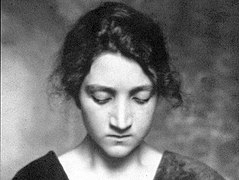Design
Design
Personality
Chart Properties
Your Cross represents the specific theme of your life. This cross embodies your unique potential & the lessons you're here to learn, providing a roadmap to fulfilling your life purpose.
We use the UTC birth time and date to do the calculations required to generate your Human Design chart.
Buy Tokens
Pay as you use, no expiry and no subscription required.Dorothy Kerin's Biography
British woman miraculously healed by an angelic vision. Stricken with tubercular meningitis and peritonitis, she was not expected to survive the night of 2/18/1912; her family was gathered around her death bed at home in South London. At 9:15 PM, she suddenly sat up and said, “Do you not hear? I am well. I must get up and walk.”
Dorothy arose, put on her dressing gown and went down to the pantry to get something to eat, finding meat and pickles in the larder. The following morning her physician found her completely well, including restoration of her formerly emaciated body. Blood tests and X-rays revealed no trace of the lesions and symptoms associated with her illness. It was a fully documented, miraculous cure.
In her book, “The Living Touch,” Dorothy describes the coma of the prior two weeks in which she had received a vision of the Lord and angels, asking her if she would go back. She said she had been charged to “heal the sick, comfort the sorrowing and give faith to the faithless”.
The next 17 years were a time of retreat and preparation for this ministry. Dorothy lived with Dr. and Mrs. Langford-James as their adopted daughter. Dr. Langford-James was an Anglo-Catholic priest who became her spiritual director. Dorothy described this time as “Long spells of quiet and prayer to delight in.” She was following the lead of the Lord without knowing where she was headed.
By 1929, her path within the healing ministry was becoming clear. She rented a house in Ealing to establish her first Home of Healing. An unexpected gift the following year enabled her to renovate and furnish the house and within months, Chapel House was ready for its first patients. Dorothy wrote of these years, “God’s wondrous power was made manifest in countless blessings and acts of healing.”
Throughout the difficulties of the war years, Dorothy kept expanding up to seven properties and nine adopted children. Eventually she took over the estate of Speldhurst in Kent, a dilapidated house that needed restoration. Dorothy divided her time between Chapel House in Ealing and Speldhurst. Eventually, she sold Chapel House and opened Burrswood, where she served the final period of her healing ministry. Local clergy, doctors and villagers regarded the house as suspect in spite of the fact that it was registered as a Nursing Home where orthodox medical care was combined with Christian prayer and counsel.
Dorothy Kerin died in 1963. Since then her work has been carried on by a Trust that bears her name. In 1989 The Burrswood Endowment Trust was set up with the vision of ensuring the financial future of Burrswood. The capital sum in the Endowment Trust continues to grow and be invested. The interest from this is given to the Bursary Fund and enables many patients who are unable to afford the full cost of their care to benefit from a stay here. The Burrswood Endowment Trust is a separate body from the Dorothy Kerin Trust, apart from one shared Trustee.
Dorothy Kerin¹s own home, which is called Chapel House, is now a sixteen-bed guest-house, where people are able to stay for private retreats or time apart.
Central to the life of Burrswood is the very beautiful Church of Christ the Healer, built in 1959, under the direction of Dorothy Kerin, following a vision granted to her. Here the office and Holy Communion are offered daily for the work of healing at Burrswood and throughout the world. Four times a week public Healing Services are held, to which visitors, patients and guests come for the laying on of hands and prayer.
Dorothy Kerin
Your Cross represents the specific theme of your life. This cross embodies your unique potential & the lessons you're here to learn, providing a roadmap to fulfilling your life purpose.
We use the UTC birth time and date to do the calculations required to generate your Human Design chart.





